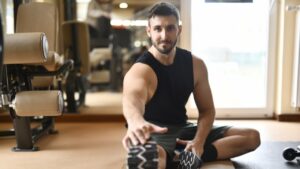Stretching is a fundamental part of fitness routines worldwide enhancing flexibility and enhances flexibility. When it comes to stretching, the two most common types — static and dynamic stretching — serve distinct purposes and are recommended at different times during your exercise routine.
Static stretching is often reserved for cooling down, helping muscles relax after a workout. Meanwhile, dynamic stretching is used during warm-ups to prepare the body for physical activity. Understanding the differences between these stretching types can transform your approach to workouts – aiding in better performance and recovery.


What Is Static Stretching?
Static stretching involves elongating a muscle or group of muscles to their furthest point and then holding that position for a period of time (typically between 15 to 60 seconds). This form of stretching is most beneficial after physical activity, as it helps to lengthen the muscles that were contracted during exercise, promoting relaxation and may diminishing the risks of muscle cramps and stiffness.
Static stretches help in cooling down the body gradually and prepare the muscles for rest after vigorous activity. By regularly adding static stretching into your post-workout routine you may enhance your overall flexibility. This type of stretching not only helps in muscle recovery but also improves blood circulation to the stretched areas, may help facilitate better recovery. .
The Benefits of Static Stretching
Static stretching is known to massively improve flexibility and joint range of motion. Regular static stretching can help maintain muscle health, allowing for a smoother transition between physical activity and daily life.
Another advantage of static stretching is its effect on overall relaxation. By holding stretches for extended periods, you can help reduce muscle tension and promote relaxation throughout the body. This can be particularly beneficial for individuals looking to improve both their physical and mental wellbeing as it helps decrease stress and anxiety levels after intense workouts.

How to Perform Static Stretches
Performing static stretches properly is key to obtaining the maximum benefits without risking injury. For example, to effectively stretch the hamstrings, you can try a simple toe touch:
- Stand straight with your feet hip-width apart.
- Slowly bend forward at the hips, lowering your hands towards your feet.
- Reach as far as comfortable, aiming to touch your toes, and hold this position for 20-30 seconds.
For the quadriceps, a standing stretch can be effective:
- Stand on one leg, holding onto a stable surface for balance if needed.
- Bend your other leg back, bringing your heel towards your buttock.
- Grasp your ankle with your hand and pull slightly to increase the stretch, holding for 20-30 seconds.
By stretching slowly and holding each position, you can maximise the effectiveness of your post-workout cool-down, contributing to better flexibility and decreased muscle tension.
What Is Dynamic Stretching?
Dynamic stretching involves movements with active muscular effort to stretch a particular muscle or group of muscles. This type of stretching is ideal before starting a workout as it helps to prepare the body for physical activity by warming up the muscles, increasing blood flow, and improving range of motion.
Dynamic stretches mimic the motions of the exercise or sport that will follow, which makes them particularly effective for sports performance enhancement.
The movements in dynamic stretching are typically repetitive and gradually increase in reach or speed to maximise muscle activation. This form of stretching helps to activate the neural pathways, preparing the muscles for quick and efficient response during sports or other physical activities.
The Benefits of Dynamic Stretching
Dynamic stretching can increase muscle temperature and blood flow, which can reduce the risk of injuries and improve overall athletic performance. By incorporating dynamic stretches into your pre-workout routine, you can enhance muscular performance and agility, which are essential for high-intensity workouts or sports.
Additionally, dynamic stretching helps to improve overall range of motion and kinetic awareness, which are crucial for maintaining optimal body movement during physical activities. The activation of muscles that occurs during dynamic stretching also aids in improving the efficiency of the upcoming workout, ensuring that the body is well prepared for the stress of exercise.

How to Incorporate Dynamic Stretches into Your Routine
Integrating dynamic stretches into your workout routine can be simple and effective:
- Leg Swings: Stand on one leg and swing the other leg forward and backward progressively increasing the height of each swing. This helps prepare the hip muscles for exercise.
- Arm Circles: Extend your arms parallel to the ground and perform small circles that gradually get larger. This is excellent for the shoulders before upper-body workouts.
These examples illustrate how dynamic stretches can be easily included in your warm-up to prepare your body for exercise and prevent injuries.
Comparing Static vs. Dynamic Stretching
When comparing static and dynamic stretching, it’s important to recognize their unique benefits and optimal timing during your fitness routine. Static stretching is best used after exercising when muscles are warm and pliable. This allows for deeper stretches without the risk of injury. In contrast, dynamic stretching is ideal before exercise, preparing the muscles for the range of motion and stresses to come.
When to Use Static vs. Dynamic Stretching
Choosing when to use static vs. dynamic stretching can significantly affect your flexibility and injury risk:
- Before Exercise: Utilise dynamic stretching to warm up the muscles with movements that closely resemble those of the upcoming exercise.
- After Exercise: Employ static stretching to help muscles recover and increase flexibility.
Best Practices for Stretching Safely and Effectively
To stretch safely and effectively, always warm up your muscles with dynamic stretches before engaging in intensive exercise to prevent injuries. After finishing your workout, cool down with static stretches to promote muscle recovery and increase flexibility. Be mindful not to overstretch to the point of pain and ensure each stretch is performed slowly and with control.

Tips for Designing Your Stretching Routine
Design your stretching routine to include both static and dynamic stretches to maximise flexibility and prepare your body for different physical activities. Tailor your stretches to the particular muscles that will be used most extensively during your workout, and listen to your body to avoid overstretching.
This exploration into static and dynamic stretching provides a solid foundation for integrating these essential techniques into your fitness routine, enhancing both your performance and your enjoyment of physical activities.
Disclaimer: The information on this page is for informational purposes only. Do not start new exercise without the recommendation of a professional.
Book an appointment at Coast Sport by calling (02) 4356 2588 or book online via the button below.


 Helping the Central Coast Feel Well, Move Well and Perform Well!
Helping the Central Coast Feel Well, Move Well and Perform Well!